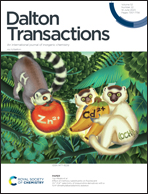Mapping the influence of ligand electronics on the spectroscopic and 1O2 sensitization characteristics of Pd(ii) biladiene complexes bearing phenyl–alkynyl groups at the 2- and 18-positions†
Abstract
Photodynamic therapy (PDT) is a promising treatment for certain cancers that proceeds via sensitization of ground state 3O2 to generate reactive 1O2. Classic macrocyclic tetrapyrrole ligand scaffolds, such as porphyrins and phthalocyanines, have been studied in detail for their 1O2 photosensitization capabilities. Despite their compelling photophysics, these systems have been limited in PDT applications because of adverse biological side effects. Conversely, the development of non-traditional oligotetrapyrrole ligands metalated with palladium (Pd[DMBil1]) have established new candidates for PDT that display excellent biocompatibility. Herein, the synthesis, electrochemical, and photophysical characterization of a new family of 2,18-bis(phenylalkynyl)-substituted PdII 10,10-dimethyl-5,15-bis(pentafluorophenyl)-biladiene (Pd[DMBil2-R]) complexes is presented. These second generation biladienes feature extended conjugation relative to previously characterized PdII biladiene scaffolds (Pd[DMBil1]). We show that these new derivatives can be prepared in good yield and, that the electronic nature of the phenylalkynyl appendages dramatically influence the PdII biladiene photophysics. Extending the conjugation of the Pd[DMBil1] core through installation of phenylacetylene resulted in a ∼75 nm red-shift of the biladiene absorption spectrum into the phototherapeutic window (600–900 nm), while maintaining the PdII biladiene's steady-state spectroscopic 1O2 sensitization characteristics. Varying the electronics of the phenylalkyne groups via installation of electron donating or withdrawing groups dramatically influences the steady-state spectroscopic and photophysical properties of the resulting Pd[DMBil2-R] family of complexes. The most electron rich variants (Pd[DMBil2-N(CH3)2]) can absorb light as far red as ∼700 nm but suffer from significantly reduced ability to sensitize formation of 1O2. By contrast, Pd[DMBil2-R] derivatives bearing electron withdrawing functionalities (Pd[DMBil2-CN] and Pd[DMBil2-CF3]) display 1O2 quantum yields above 90%. The collection of results we report suggest that excited state charge transfer from more electron-rich phenyl-alkyne appendages to the electron deficient biladiene core circumvents triplet sensitization. The spectral and redox properties, as well as the triplet sensitization efficiency of each Pd[DMBil2-R] derivative is considered in relation to the Hammett value (σp) for each biladiene's R-group. More broadly, the results reported in this study clearly demonstrate that biladiene redox properties, spectral properties, and photophysics can be perturbed greatly by relatively minor alterations to biladiene structure.

- This article is part of the themed collection: Spotlight Collection: Photoinduced redox chemistry


 Please wait while we load your content...
Please wait while we load your content...
